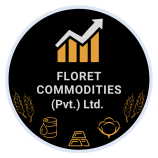Are you trying to take advantage of the current economic instability? It may appear difficult to navigate the present economic environment given the extreme inflation and volatile interest rates. Still, it offers a unique chance.
Trading through Risk Management, you may take advantage of market movements and increase your revenue.
When the value of your hard-earned money is vulnerable to inflation, Floret Commodities provides a solution to protect and even increase your wealth. Online trading has become an invaluable resource for astute traders looking to avoid the world economy’s volatile situations. However, in order to succeed, one must have both the knowledge and abilities required to use the relevant tools. At this stage, risk management becomes a partner in your successful trading endea
Position sizing
The ratio of a single position size to the entire capital is known as position sizing. The 1% rule, which states that a position’s size should never exceed 1% of the entire capital, is embraced by profitable traders.
For instance, the margin you assign to a trade should be less than $100 if your capital is $10,000. The leftover capital protects you against a close-out and acts as a buffer against the shifting profits and losses (P/L). The risk factors and volatility of each asset vary. Therefore, you can create a balance between the investment and the risk by modifying your position sizing technique appropriately. This strategy exemplifies effective risk management by mitigating potential losses and optimizing capital allocation.
Stop loss and Take profit
Stop Loss (SL)
Set an SL to automatically exit a position at a predetermined price, minimizing potential losses. For stocks, place your stop loss just below key support levels or at a certain proportion of your entry price. In PMEX, base your stop loss on currency volatility. Use the Average True Range (ATR) indicator to provide direction.
Take profit (TP)
In contrast, TP orders, which sell as soon as your profit target is met, lock in your gains. When it comes to stocks, aim for past records or returns of 10% to 20%.
Match stop-loss points (TP) for commodities and forex with important market levels or a desirable risk-reward ratio.
Working out the ideal spots for SL and TP is direct. Utilize a proper level of your venture to characterize the SL and set the TP at a point that offers a gamble/reward proportion that matches your system, such as 1:2. For example, in a Forex exchange, to gamble over 1%, you’d set SL 50 pips away with a $2 esteem for every pip. This sets you up for a potential $200 gain if your TP is 100 pips away.
Diversification
Investors seek to minimize the impact of unfavorable situations on a certain investment or industry through diversification. It distributes risk and increases the likelihood of steady returns.
A trader heavily invested in technology stocks. To mitigate risks like market volatility and regulatory changes, they diversify into sectors like healthcare, consumer goods, and energy. This strategy spreads risk across industries, ensuring their portfolio isn’t overly affected by issues specific to one sector. Diversification helps maintain stable returns over time, even if certain sectors underperform.
Risk/reward ratio
Maintain the force of the risk/reward ratio to make determined and critical trading decisions:
This is the equilibrium size of exchanging, contrasting what you’re willing to lose (risk) against what you expect to acquire (reward). A basic measurement guides merchants in distinguishing places that are probably going to be productive.
For Example: Imagine you’re considering investing in a stock priced at $70, expecting it to rise. You decide to set a stop-loss at $65 to safeguard against a downturn — representing a $5 risk. You anticipate the stock could climb to $85, offering a potential $15 gain. This setup provides you with a risk/reward ratio of 1:3 — for every dollar at risk, you foresee tripling your potential reward.
Conclusion
In this blog, we discussed three important things that investors must keep in mind. The first is Position Sizing, which involves determining the ratio of a single position size to total capital. The second is Stop Loss and Take Profit, which involves determining the appropriate levels of risk for stop loss (SL) and take profit (TP). , The third is Diversification, which involves spreading investments across multiple assets to reduce the impact of any single asset’s performance on the overall portfolio. Lastly, we talked about risk/reward ration, which is to make determined and critical trading decisions
Now, it is time to guarantee your financial future with Floret Commodities. Floret Commodities provides powerful analytics, user-friendly tools, and effective risk management solutions. Join our trading community today to confidently navigate economic trends and protect your investments.




